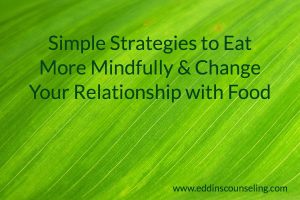April 6, 2016
Simple Strategies to Eat More Mindfully and Change Your Relationship with Food
Written by Rachel Eddins
Posted in Emotional Eating & Body Image, Tools & Exercises and with tags: Compulsive Eating, Overeating, binge eating, disordered eating, mindfulness, weight loss

Are you tired of struggling with food? Do you find yourself thinking about what you will eat later in the day or wondering where your food just went? Do you eat quickly or while engaging in other activities such as watching TV, or working on the computer? Have you tried to change your eating, with little success?
Many struggles with overeating, weight gain, and powerlessness around food can be tied to mindless eating. That is, eating while distracted or in reaction vs. response to triggers. Mindful eating is eating with the intention of nurturing yourself and being aware of the process of eating, your enjoyment of your food and its effects on your body. The more present you are with eating, the more you may be satisfied with less.
While it sounds deceptively simple, mindful eating can be difficult for a number of reasons. Some people find that mindfully paying attention to food isn’t as enjoyable when food is used to numb, distract, or soothe.
Some find the habit of slowing down enough to pay attention challenging. Our minds are busy and we’re used to going, going, going. The simplest way to think about mindful eating is PAUSE and notice. Even if just for a moment, adding in the pause can make a huge difference in the long-term.
Mindful eating questions to ask before you eat:
-
Am I hungry?
Take a deep breath and imagine a fuel gauge inside your abdomen that measures how hungry or full you are. 1 is starving, famished. 2 is hungry, 3 is satisfied, just comfortable, 4 is full, and 5 is absolutely stuffed. Give yourself a number that rates your hunger number right now. If you don’t know give it your best guess. If you are below a 3 it’s a great time to eat. Proceed to question number 2.
-
If yes, what does my body want to eat?
Keep your hand on your abdomen and check in and see if you get a sense of what your body would want. The body is often quite selective. If you don’t know, then get more specific.
What temperature would I want. Would it be hot, cold or room temperature. And the taste is it spicy, sweet or salty? And what texture would feel good? Creamy, crunchy or smooth? Is it hearty like roast beef or light like a salad. If you check in and still don’t get an answer there’s a chance that you might not be hungry.
-
If no, I’m not hungry, then what do I really want?
When you have an urge to eat and you’re not physically hungry you may be emotionally hungry. Then ask yourself, what am I feeling?
You may be bored, scared, exhausted, anxious, worried, angry, stressed or any other feeling. Say to yourself, I’m not hungry, I’m … and choose a word that best fits what you’re feeling.
So say, I’m not hungry, I’m frustrated. Feelings are messages trying to get through – needs wanting to be met.
So ask them the question, what do I really want and give yourself whatever you need when you can? Checking in takes practice. When you reach for comfort food its likely that you’re really wanting a way to soothe, comfort and nurture yourself. You will gradually find other ways to get those needs met, but only if you ask yourself that 3rd magic question. What do I really want? This question invites you peek inside your own inner world and opens the path to self discovery.
If you decide that you are hungry… ask yourself these mindful eating questions:
- Check in with your body and ask, “how hungry am I?”
- How do you know? What sensations do you experience?
- When was the last time you ate?
- Is this stomach or head hunger?
- What am I hungry for?
- Taste? Texture? Temperature?
- Snack or meal hunger?
- See questions in step 2 above.
- How do I eat?
- Make eating it’s own activity and not multitasking.
- Eat mindfully and check in for satisfaction and fullness.
- Use a smaller plate and a serving plate – you can always serve yourself more.
- How much is enough?
- Stop at 2/3 full and check in – how do you feel physically? Then decide whether to continue eating or pause.
- What cues let you know that you are satisfied?
- Try stopping a bit earlier than usual and test how you feel 1-2 hours later.
Strategies to help you slow down and practice mindful eating:

- Eat Your Favorite Food Last. The last bite of food you eat lingers longer in your memory as well as on your palate. Strategically saving the best bite for last can help you to feel satisfied longer.
- Don’t Try and FIGHT Your Thoughts About Food. Telling yourself not to think about it results in obsessing about it and ultimately eating more than if you approached your craving mindfully. Research shows that those who tried not to think about eating chocolate ate more than those who intentionally thought about chocolate. Next time you have a craving, stop and check in with your internal state. Are you hungry, tired, bored? What do you need? Allow yourself to think about what about you want and decide what and how much you want to eat. The key here is to pause so you can respond vs. react.
- Make Your First Bite a Mindful Bite. Rather than trying to eat an entire meal or snack mindfully, focus on your first bite. Small steps ultimately lead to large change. When you sit down to eat, stop and notice your food. Check in with your body and notice your body’s response to the anticipation of your first bite. With your first bite, notice how it tastes in your mouth giving yourself time to chew before swallowing. Pay special attention to the pleasure and satisfaction you received from that first bite of food. Notice how your body feels after that first bite.
- Set Your Intention Through Gratitude. Saying a word of gratitude prior to eating can help you shift your mood to relaxed and your intention to the nourishment of the meal you are eating. Eating in a relaxed way helps your body to digest properly and increases your ability to eat mindfully.
- Take 3-5 Deep Breaths Before You Eat. Slowing down and relaxing your body can help you be in the present moment while you eat. This can also be helpful for responding vs. reacting to cravings and digesting your food more effectively. Advanced tip: add deep breaths while you are eating to stay connected to the present.
- Sit Down When You Eat. Do you commonly eat on the go, in front of the refrigerator, or in the car? Creating a pleasing environment for eating can help you shift your attention back onto your experience of eating. Sitting down can help you s..l..o..w down, which can help you feel both relaxed and satisfied longer.
- If It’s Difficult to Eat with No Distractions, Put Your Fork Down and Alternate Eating with Distraction. Some people find it hard to simply focus on their food without distractions. If you prefer to read, talk, or (must) wrangle children while eating, put your fork down while you are engaging in that activity. Then focus on eating when you are eating. Shift back and forth, don’t try and do both at the same time.
- Eat with Compassion. We don’t practice mindfulness perfectly, nor do we eat perfectly. Give yourself permission to be imperfect. Sometimes you need to soothe, sometimes you need comfort and sometimes you need a break. Being mindful is about noticing that you need to soothe, comfort, or distract and it’s ok, you can give yourself some kindness for being human.
- Practice Using a Mindful Delay. If you feel stressed and cravings are strong, slow down and take a deep breath and check in with your body. What do you need? If that feels challenging, try chewing a piece of peppermint gum until you can slow down enough to decide what you need.
- Cope Effectively with Your Emotions. Stress, overwhelm, anger, sadness can all trigger food cravings and lead to mindless eating. Rather than trying to change what you eat, focus on your feelings. Identify what you need and what helps you cope: connecting with others, calming your senses, releasing through creativity, shifting your attention to an absorbing story, physically moving to relieve tension, shifting your mindset.
- Eat Pleasurable Foods Mindfully. Rather than limiting pleasurable food, make a “date” with them. Choose to eat them when you feel relaxed vs. using them TO relax. Savor each bite and enjoy the satisfaction and pleasure they provide.
- Look for the Exceptions. Rather than saying, “I can’t have just one,” or “I don’t know how to stop,” notice when you can. Pay attention to your environment, senses, mood, internal body cues. Notice what is different about the exceptions. This can help you identify when you are more likely to engage in mindful eating practices.
- Try closing your eyes while eating. This can help you focus in on the act of eating vs the visual cues of what is on your plate.
- Imagine eating triggering food before your first bite. If you’re having dessert or a special treat for example, take a few deep breaths, close your eyes and imagine eating the food mindfully. This jumpstarts the process of releasing dopamine, the brain’s feel-good chemical that can be a trigger for craving more. After that exercise, eat your dessert mindfully and enjoy! Notice if you feel more satisfied.
- Use grounding and self-soothing skills if you’re feeling triggered emotionally. Take care of your emotional needs without using food. Start by practicing skills to ground, self-soothe and regulate emotions. THEN ask yourself whether you are hungry.
Read our Guide to Emotional Eating and learn more about strategies to overcome emotional eating.
Mindfulness Exercise for Food Cravings
- When you have the “I want” urge, PAUSE! Tune into your feelings and use your body for clues. Notice your physical state. Take a few deep breaths with a long exhale. Identify your need. What’s triggering your craving? Is it fatigue, hunger, thirst? Entertain your options, then decide what you will do.
- Find a comfortable position and tune into the present moment. Practice a mindfulness strategy to help you get present.
- Notice the urge, pause and mindfully observe the urge in your body as it moves up and down in intensity like a wave without giving in to it. Trust that the urge will pass. Practice with less intense urges, such as the urge to move your feet or shift your weight.
- Use calming or soothing words to remind yourself that “this will pass.”
- If your thoughts are focused on the food, shift your thoughts to mindfully attend to a neutral object such as a picture on the wall.
- Have a glass of water. Being hydrated helps you think clearer and can curb your appetite. People often mistake thirst for hunger.
- Avoid eating in front of the TV; research shows people eat the most when also watching TV.
- Pursue another activity. If you don’t turn to eating, you need to put something else in its place.
Mindfulness Exercise with Food
Now that you’ve prepared for mindful eating using the strategies above, you’re ready to try a mindfulness exercise with food.
- Begin this exercise when you are in a relaxed state, and not triggered emotionally, rushed for time, bored or distracted.
- Create a pleasing ambiance such as a clear table, music, or similar environment.
- Choose a time when you aren’t so hungry to begin with that you’re feeling famished or ravenous, but rather slightly hungry.
- Select food that is neutral to you, not something you typically crave.
- Ensure you have food available, especially if you are meal hungry, so that you can calm anxious feelings of deprivation if you begin and awaken your hunger.
- Take several deep breaths before beginning.
- Be sure you are seated, not standing at the counter or in front of the TV, which are common places for mindless eating.
- Set out you food on a small plate in front of you.
- When you’re ready, follow the instructions for the mindfulness exercise below.
Instructions for the Mindfulness Exercise with Food
Notice the color of the food, the shape, and the size. Bring it close to your mouth; see if you can detect an aroma. Place it on your tongue, notice the texture. Notice the initial taste. Salt, sweet, sour, bitter. Take a bite. Notice the way the food feels as it is compressed between your teeth. Note any changes in the flavor and texture that occur with chewing. Notice the rate. What happens when you slow down, speed up.
Allow yourself to find a natural rhythm for chewing, try pay attention to each time you chew or swallow without slowing or speeding up. Judgments, thoughts, emotions and body sensations may come up. Make a note, this is natural, no matter what is intruding, turn your thoughts back to the taste, textures, sensations, impulses to speed up, slow down.
Allow yourself to appreciate the taste, the energy, and your aliveness. If you notice a judgment, remember to reassign it as a preference, focus on staying with what your experience is now. Now, Redirect yourself to take another bite and notice the burst of flavor associated with the new bite.
Remember, if thoughts enter your mind, fears about the food or judgments… go ahead and note them … worries, distractions, ideas, and deliberately, gently redirect your thoughts to the sensation. Go ahead and take a minute to focus on the sensations associated with eating.
- You can try a similar mindful eating exercise with food using John Kabat Zinn’s Raisin Exercise
Make Peace with Food Program
If you’re ready to learn new strategies to have a healthier relationship with food, join our Make Peace with Food Program. The program starts April 2016. This is a 12-week program to help you:
- Practice intuitive and mindful eating
- Learn how to cope with emotion driven eating and cravings
- Build self-connection and self-compassion skills to cope with the inner critic and black and white thinking
- Cope effectively with stress and challenges that increase overeating
To get started give us a call to schedule an appointment at 832-559-2622 or schedule an appointment online.



















